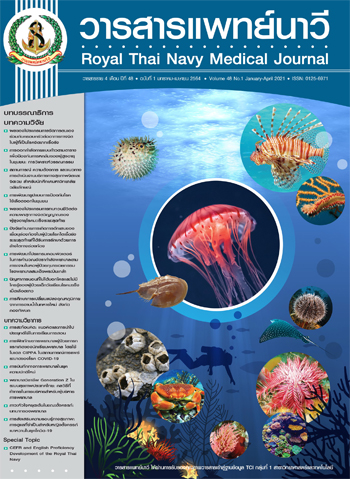การศึกษาการเปลี่ยนแปลงอุณหภูมิกายจากการอาบน้ำในทหารใหม่ สังกัดกองทัพบก
Main Article Content
บทคัดย่อ
การอาบน้ำระหว่างวันเป็นมาตรการที่เพิ่มเติมขึ้นในบางหน่วยฝึกทหารใหม่เพื่อเพิ่มประสิทธิภาพการป้องกันการบาดเจ็บจากความร้อนแต่ยังไม่ทราบระยะเวลาในการอาบน้ำที่เหมาะสม การศึกษานี้จึงมีวัตถุประสงค์เพื่อเปรียบเทียบความแตกต่างของอุณหภูมิกายที่เปลี่ยนแปลงจากการอาบน้ำในระยะเวลาที่แตกต่างกันของทหารเกณฑ์ที่เข้ารับการฝึกหลักสูตรทหารใหม่ในรูปแบบการศึกษาตามรุ่นย้อนหลัง จากข้อมูลการปฏิบัติในหน่วยฝึกทหารกองประจำการ 3 หน่วย จำนวน 277 คน ระยะเวลาในการอาบน้ำเริ่มจับเวลาตั้งแต่ปล่อยตัวเข้าห้องน้ำจนถึงกลับมารายงานตัวหลังออกจากห้องน้ำ ความเปลี่ยนแปลงของอุณหภูมิกายคำนวณจากอุณหภูมิก่อนอาบน้ำลบอุณหภูมิหลังอาบน้ำซึ่งถูกวัดโดยเครื่องวัดอุณหภูมิประจำหน่วยงานนั้นๆ แล้วศึกษาอุณหภูมิกายเปลี่ยนแปลงเฉลี่ยแยกตามระยะเวลาที่อาบน้ำแล้วทดสอบความแตกต่างกันของอุณหภูมิกายจากระยะเวลาที่อาบน้ำที่ต่างกัน
ผลการศึกษา พบว่า กลุ่มตัวอย่างทั้งหมดเป็นเพศชาย อายุ 21 - 22 ปี ร้อยละ 93.50 เป็นผู้มีดัชนีมวลกายปกติ ร้อยละ 68.23 การอาบน้ำส่งผลให้อุณหภูมิกายลดลงมากที่สุดเมื่ออาบน้ำ 35 นาที เท่ากับ 0.45 ± 0.14 องศาเซลเซียส และลดลงน้อยที่สุดที่ระยะเวลา 5 นาที เท่ากับ 0.03 ± 0.20 องศาเซลเซียส ระยะเวลาอาบน้ำที่ต่างกันส่งผลให้เกิดการเปลี่ยนแปลงของอุณหภูมิกายที่แตกต่างกัน อย่างมีนัยสำคัญทางสถิติ (p < .05) ทุกคู่ยกเว้นระยะเวลาที่ 5 - 10 นาที และระยะเวลาที่ 20 - 25 - 30 นาที ที่ไม่พบความแตกต่างกัน โดยสรุประยะเวลาอาบน้ำที่แตกต่างกันส่งผลต่อความเปลี่ยนแปลงของอุณหภูมิกายที่แตกต่างกัน จึงควรศึกษาเพิ่มเติมให้แน่ชัดและนำไปปรับใช้อย่างเหมาะสม
Article Details

อนุญาตภายใต้เงื่อนไข Creative Commons Attribution-NonCommercial-NoDerivatives 4.0 International License.
เอกสารอ้างอิง
Health Promotion and Prevention Medicine Division. The Royal Thai Army Medical Announcement: recommendation for prevention and surveillance and first aids and treatment of heat related injury. In: corps TRTAM, editor. Bangkok: Health Promotion and Preventive Medicine Division; 2013. (in Thai).
Agency USEP. Climate change indicators: heat-related deaths 2016. [Internet]. [cited 2021 February 1]. Available from: https://www.epa.gov/climate-indicators/climate-change-indicators-heat-related-deaths.
Thepnarin N, Buapetch A, Isaramalai S. Development of heat injury prevention program among the Royal Thai Army recruits. Songklanagarind Journal of Nursing 2017;37(4):69-82. (in Thai).
Phivgategaew S, Chomchai S, Dumavibhat N, Sujirarat D. Comparison of initial BMI in moderate to severe heat-related illness among Royal Thai Navy Task Force Trainees. Royal Thai Navy Medical Journal 2019;46(1):49-65. (in Thai).
Hattachot P. Knowledge management and technology transfer for the innovation RTA heat stroke mobile application for heat related illnesses prevention among new army conscripts during the basic training. National Research Council of Thailand; 2019. (in Thai).
Health Promotion and Prevention Medicine Division. Heat related injury surveillance and first aid (medical staff) handbook. Bangkok: The Royal Thai Army Medical; 2012. (in Thai).
McDermott BP, Casa DJ, Ganio MS, Lopez RM, Yeargin SW, Armstrong LE, et al. Acute whole-body cooling for exercise-induced hyperthermia: a systematic review. J Athl Train 2009;44(1):84-93.
Deepreecha K, Seehabun W, Saengdidtha B. 100 The effectiveness of daytime bath among new conscripts in a training unit for heat injury prevention 2018. Occupational and Environmental Medicine 2018;75(Suppl 2):A502-3.
Juliff LE, Halson SL, Bonetti DL, Versey NG, Driller MW, Peiffer JJ. Influence of contrast shower and water immersion on recovery in elite netballers. J Strength Cond Res 2014;28(8):2353-8.
Truxton TT, Miller KC. Can temperate-water immersion effectively reduce rectal temperature in exertional heat stroke? A critically appraised topic. J Sport Rehabil 2017;26(5):447-51.
Tan PM, Teo EY, Ali NB, Ang BC, Iskandar I, Law LY, et al. Evaluation of various cooling systems after exercise-induced hyperthermia. J Athl Train 2017;52(2):108-16.
Butts CL, McDermott BP, Buening BJ, Bonacci JA, Ganio MS, Adams JD, et al. Physiologic and perceptual responses to cold-shower cooling after exercise-induced hyperthermia. J Athl Train 2016;51(3):252-7.
Luhring KE, Butts CL, Smith CR, Bonacci JA, Ylanan RC, Ganio MS, et al. Cooling effectiveness of a modified cold-water immersion method after exercise-induced hyperthermia. J Athl Train 2016;51(11):946-51.
DeMartini JK, Ranalli GF, Casa DJ, Lopez RM, Ganio MS, Stearns RL, et al. Comparison of body cooling methods on physiological and perceptual measures of mildly hyperthermic athletes. J Strength Cond Res 2011;25(8):2065-74.
Nye EA, Edler JR, Eberman LE, Games KE. Optimizing cold-water immersion for exercise-induced hyperthermia: an evidence-based paper. J Athl Train 2016;51(6):500-1.
Legrand A, Schütz KE, Tucker CB. Using water to cool cattle: behavioral and physiological changes associated with voluntary use of cow showers. J Dairy Sci 2011;94(7):3376-86.
Ajjimaporn A, Chaunchaiyakul R, Pitsamai S, Widjaja W. Effect of cold shower on recovery from high-intensity cycling in the heat. J Strength Cond Res 2019;33(8):2233-40.
Dupont WD, Plummer WD. Power and sample size calculations: a review and computer program. Control Clin Trials 1990;11(2):116-28.
Stephens JM, Sharpe K, Gore C, Miller J, Slater GJ, Versey N, et al. Core temperature responses to cold-water immersion recovery: a pooled-data analysis. Int J Sports Physiol Perform 2018;13(7):917-25.
Glen P, McGinn K, McGinn R. Restoration of thermoregulation after exercise. J Appl Physiol 2017;122:933-44.


